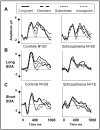Semantic activation and verbal working memory maintenance in schizophrenic thought disorder: insights from electrophysiology and lexical ambiguity
- PMID: 18450179
- PMCID: PMC2681260
- DOI: 10.1177/155005940803900217
Semantic activation and verbal working memory maintenance in schizophrenic thought disorder: insights from electrophysiology and lexical ambiguity
Abstract
We have examined language processing using ambiguous words (homographs like panel or toast) and rapid or slow presentation rates while recording event-related brain potentials (ERPs). Homographs allow for tracking the train of thought at points of lexical ambiguity and detecting modulation of associative threads by previous context. Rapid presentation rates stress automatic semantic activation, and slow rates stress controlled verbal working memory contextual modulation. In conjunction with reaction times and performance, ERPs allow for objective measurement of activity related to language processing from word presentation through overt behavioral response. Smaller N400 to related and unrelated items at short stimulus onset asynchronies (SOAs), the presence of a semantic bias, and large N400 to related and unrelated items at long SOAs are present in schizophrenia. We describe a model of initial semantic memory hyper-priming and subsequent decay of information in verbal working memory stores, the activation-maintenance model of schizophrenic thought disorder hypothesized to underlie the thought disorder in schizophrenia.
Figures



References
-
- Bleuler E. International Universities Press; New York: 1950. (1911). Translated by Zinkin J. Dementia Praecox, or the Group of Schizophrenias.
-
- Shiffrin RM, Schneider W. Controlled and automatic human information processing: II. Perceptual learning, automatic attending, and a general theory. Psychol Rev. 1977;84:127–185.
-
- Posner MI, Snyder CRR. Facilitation and inhibition in the processing of signals. In: Rabbit PMA, editor. Attention and Performance. vol 5. Academic Press; London: 1975.
-
- Collins AM, Loftus EF. A spreading-activation theory of semantic processing. Psychol Rev. 1975;82:407–428.
-
- Schvaneveldt R, Meyer D. Retrieval and comparison processes in semantic memory. In: Kornblum S, editor. Attention and Performance. vol IV. Academic Press; New York: 1973.
Publication types
MeSH terms
Grants and funding
LinkOut - more resources
Full Text Sources
Medical

